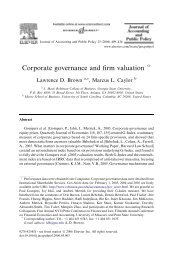Income Dynamics, Economic Rents and the Financialization of the ...
Income Dynamics, Economic Rents and the Financialization of the ...
Income Dynamics, Economic Rents and the Financialization of the ...
Create successful ePaper yourself
Turn your PDF publications into a flip-book with our unique Google optimized e-Paper software.
finance sector employees were not extended to all employees. In all four finance sector industries<br />
<strong>the</strong> post-1980 rise in industry rents went primarily to highly educated employees in managerial,<br />
pr<strong>of</strong>essional <strong>and</strong> sales occupations. There were limited or no income benefits to lower level oc-<br />
cupations <strong>and</strong> less educated workers. In addition, for each industry white men see income growth<br />
beyond <strong>the</strong>ir human capital <strong>and</strong> occupational positions in all four industries after 1980, while<br />
minority men <strong>and</strong> women <strong>and</strong> white women display flat income trajectories (analyses available<br />
upon request). Thus compared to national trends in income inequality (e.g. Morgan <strong>and</strong> McKer-<br />
row 2004) <strong>the</strong> finance sector is unusual in that <strong>the</strong>re are increased earnings rents to white men,<br />
even net <strong>of</strong> <strong>the</strong>ir privileged occupational position.<br />
In order to gauge <strong>the</strong> aggregate income rents transferred to <strong>the</strong> finance sector during <strong>the</strong><br />
period <strong>of</strong> financialization we explored a counterfactual analysis in which we ask what would<br />
current pr<strong>of</strong>it <strong>and</strong> compensation levels in <strong>the</strong> finance sector look like if <strong>the</strong>ir income claims <strong>and</strong><br />
employment as a proportion <strong>of</strong> <strong>the</strong> national economy had stayed at <strong>the</strong> 1948-1980 historical le-<br />
vels? 20 We approach <strong>the</strong>se estimates with two simple counterfactuals, both <strong>of</strong> which ask what if<br />
<strong>the</strong> regulatory institutional shifts in <strong>the</strong> finance field associated with increased concentration,<br />
20 One can, <strong>of</strong> course, imagine much more elaborate counterfactuals. For example, if we assumed<br />
that financialization reduced real economic growth by diverting capital investment out <strong>of</strong> <strong>the</strong> real<br />
economy, than we might want to estimate how much income was lost by <strong>the</strong> rest <strong>of</strong> <strong>the</strong> economy<br />
because <strong>of</strong> financialization. On <strong>the</strong> o<strong>the</strong>r h<strong>and</strong>, some might argue that financialization attracted<br />
foreign investment to <strong>the</strong> US which o<strong>the</strong>rwise would have gone elsewhere thus increasing aggre-<br />
gate income beyond what would have happened in its absence. We suspect that <strong>the</strong> truth lies<br />
closer to <strong>the</strong> former than <strong>the</strong> latter, but do not have any sound basis upon which to derive plausi-<br />
ble alternative GDP growth rates.<br />
32







